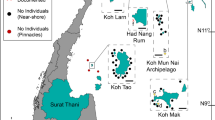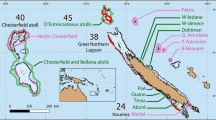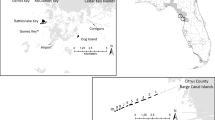Abstract
While climate change and sea level rise threaten species across the globe, species in low-lying coastal regions, such as South Florida, are projected to face particularly severe threats. One such species is the Florida reef gecko (Sphaerodactylus notatus), the only gecko native to the eastern U.S., and a highly understudied species that persists in heavily fragmented habitats of only three coastal Florida counties. To assess the conservation status of this species, we conducted surveys throughout South Florida to determine potential extirpations from historic localities and to delimit S. notatus’ current distribution. We also estimated the level of threat S. notatus faces from sea level rise relative to other species by analyzing sea level risk of all herpetofauna in the U.S. We detected geckos in only 41% of sites with appropriate habitat, and in only 65% of historic localities. Geckos were only present within 1.2 km from the coast, and the minimum 2.2 m of sea level rise already expected based on current carbon emissions will place 85% of suitable S. notatus habitat under water. Our findings were used to update the conservation risk of S. notatus according to IUCN and Florida guidelines for listing threatened and endangered species, and suggest this species now fits the criteria to warrant listing. In comparison to all other U.S. herpetofaunal species, we found that S. notatus is the most at risk from sea level rise due its fidelity to low-lying coastal habitats.





Similar content being viewed by others
Data availability
All data generated or analysed during this study are included in this published article [and its supplementary information files].
Code availability
Not Applicable.
References
Abensperg-Traun M, Smith GT (1999) How small is too small for small animals? Four terrestrial arthropod species in different-sized remnant woodlands in agricultural Western Australia. Biodivers Conserv 8:709–726
Aiello-Lammens ME, Boria RA, Radosavljevic A, Vilela B, Anderson RP (2019) spThin:Functions for spatial thinning of species occurrence records for use in ecological models. R package version 0.1.0.1 https://CRAN.R-project.org/package=spThin
Allen KE, Avilés-Rodríguez KJ, Eifler DA, Powell R (2015) Social and environmental factors influence microhabitat selection in the brown-speckled Sphaero, Sphaerodactylus notatus (Squamata: Sphaerodactylidae). J Herpetol 49:165–169
Bakker AMR, Wong TE, Ruckert KL, Keller K (2017) Sea-level projections representing the deeply uncertain contribution of the West Antarctic ice sheet. Sci Rep 7:1–7. https://doi.org/10.1038/s41598-017-04134-5
Bender MA, Knutson TR, Tuleya RE, Sirutis JJ, Vecchi GA, Garner ST, Held IM (2010) Modeled impact of anthropogenic warming on the frequency of intense Atlantic Hurricanes. Science 327:454–458
Benscoter AM, Reece JS, Noss RF, Brandt LA, Mazzotti FJ, Romañach SS, Watling JI (2013) Threatened and endangered subspecies with vulnerable ecological traits also have high susceptibility to sea level rise and habitat fragmentation. PLoS ONE 8:e70647
Ceballos G, Ehrlich PR, Barnosky AD, Garcia A, Pringle RM, Palmer TM (2015) Accelerated modern human-induced species losses: entering the sixth mass extinction. Sci Adv 1:e1400253
Clements SL, Catania SVL, Searcy CA (2019) Non-native species dominate herpetofaunal community patterns in both native and non-native habitat patches in urban Miami-Dade County. Biol Invasions 21:1775–1788
Daniels RC, White TW, Chapman KK (1993) Sea-level rise: destruction of threatened and endangered species habitat in South Carolina. Environ Manage 17:373–385
Diamond JM, Heinen JT (2016) Conserving rare plants in locally-protected urban forest fragments: a case study from Miami-Dade County, Florida. Urban For Urban Green 20:1–11. https://doi.org/10.1016/j.ufug.2016.07.008
Díaz-Lameiro AM, Oleksyk TK, Bird-Picó FJ, Martínez-Cruzado JC (2013) Colonization of islands in the Mona Passage by endemic dwarf geckoes (genus Sphaerodactylus) reconstructed with mitochondrial phylogeny. Ecol Evol 3:4488–4500
Didham RK, Lawton JH (1999) Edge structure determines the magnitude of changes in microclimate and vegetation structure in Tropical Forest Fragments. Biotropica 31:17–30
Duellman WE, Schwartz A (1958) Amphibians and reptiles of southern Florida. Bulletin of the Florida Museum of Natural History. Biol Sci 3:181–324
Dunson WA (1980) The relation of sodium and water balance to survival in sea water of estuarine and freshwater races of the snakes Nerodia fasciata N sipedon and N valida. Copeia 1980(2):268–280
Dunson WA, Bramham CR (1981) Evaporative water loss and oxygen consumption of three small lizards from the Florida Keys: Sphaerodactylus cinereus, S. notatus, and Anolis sagrei. Physiol Zool 54:253–259
Elphick CS, Roberts DL, Michael Reed J (2010) Estimated dates of recent extinctions for North American and Hawaiian birds. Biol Cons 143:617–624
FL 68A-27. Rules relating to endangered or threatened species. Florida administrative code. Last amended 18 January 2017
FNAI (Florida Natural Areas Inventory) (2019) Florida Conservation Lands Map Viewer. Florida Department of Environmental Protection. https://www.fnai.org/webmaps/ConLandsMap/
Gamble T, Bauer AM, Greenbaum E, Jackman TR (2008) Evidence for Gondwanan vicariance in an ancient clade of gecko lizards. J Biogeogr 35:88–104
Gann GD, Bradley K, Woodmansee SW (2008) Floristic Inventory of South Florida Database. Institute for Regional Conservation. Available from https://www.regionalconservation.org/ircs/FISFBackground.asp
GBIF.org (16th April 2017) GBIF Occurrence Download http://doi.org/https://doi.org/10.15468/dl.1jibqc
GBIF.org (19 September 2019) GBIF Occurrence Download https://doi.org/https://doi.org/10.15468/dl.uneazo
Hammerson GA, Buckner S, Reynolds RG, Fong A (2017) Sphaerodactylus notatus. The IUCN Red List of Threatened Species. https://doi.org/10.2305/IUCN.UK.2017-2.RLTS.T64052A3132881.en
Hass CA (1991) Evolution and biogeography of West Indian Sphaerodactylus (Sauria: Gekkonidae): a molecular approach. J Zool 225:525–561
IPCC (Intergovernmental Panel on Climate Change) 2014: Climate Change 2014: Synthesis Report. Contribution of Working Groups I, II and III to the Fifth Assessment Report of the IPCC [Core Writing Team, R.K. Pachauri and L.A. Meyer (eds.)]. IPCC, Geneva, Switzerland, 151 pp
IPCC 2019: Summary for Policymakers. In: IPCC Special Report on the Ocean and Cryosphere in a Changing Climate [H.O. Pörtner, et al. (eds.)].
IUCN. (2012a). IUCN Red List Categories and Criteria: Version 3.1. Second edition. Gland, Switzerland and Cambridge, UK: IUCN. iv + 32pp.
IUCN. (2012b). Guidelines for Application of IUCN Red List Criteria at Regional and National Levels: Version 4.0. IUCN, Gland, Switzerland and Cambridge, UK: IUCN. iii + 41pp.
Jarvis A, Reuter HI, Nelson A, Guevara E (2008) Hole-filled SRTM for the globe Version 4, available from the CGIAR-CSI SRTM 90m Database (https://srtm.csi.cgiar.org)
Jennings MR, Hayes MP (1994) Amphibian and Reptile Species of Special Concern in California. Final report submitted to the California Department of Fish and Game
Johnson AF, Barbour MG (1990) Dunes and maritime forests. In: Myers RL, Ewel JJ (eds) Ecosystems of Florida. Florida University of Central Florida Press, Orlando, pp 429–480
Kawula R, Redner J (2018) Florida land cover classification system. Final Report to the State Wildlife Grants Program, Florida Fish and Wildlife Conservation Commission
Krysko K, Sheehy C, Hooper NA (2003) Interspecific communal oviposition and reproduction of four species of lizards (Sauria: Gekkonidae) in the lower Florida Keys. Amphib Reptilia 24:390–396
Kulp SA, Strauss BH (2019) New elevation data triple estimates of global vulnerability to sea-level rise and coastal flooding. Nat Commun 10:4844
Laguna E, Deltoro VI, Pèrez-Botella J, Pèrez-Rovira P, Serra L, Olivares A, Fabregat C (2004) The role of small reserves in plant conservation in a region of high diversity in eastern Spain. Biol Cons 119:421–426
Lawson R, Frank PG, Martin DL (1991) A gecko new to the United States herpetofauna, with notes on geckoes of the Florida Keys. Herp Rev 22:11–12
López-Ortiz R, Lewis AR (2004) Habitat selection by Sphaerodactylus nicholsi (Squamata: Gekkonidae) in Cabo Rojo, Puerto Rico. Herpetologica 60:438–444
Maclean WP (1985) Water loss rates of Sphaerodactylus parthenopion (Reptilia, Gekkonidae), the smallest amniote vertebrate. Comp Biochem Physiol A Physiol 82(4):759–761
Millsap BA, Gore JA, Runde DE, Cerulean SI (1990) Setting priorities for the conservation of fish and wildlife species in Florida. Wildl Monogr 111:3–57
Misra V, et al. (2011): Climate Scenarios: A Florida-Centric View, Florida Climate Change Task Force. [Available online at https://floridaclimate.org/whitepapers/]
NOAA (2019) National Storm Surge Hazard Maps. Available at https://noaa.maps.arcgis.com/apps/MapSeries/index.html?appid=d9ed7904dbec441a9c4dd7b277935fad&entry=1
NOAA (2020). Sea Level Rise Data Download. https://coast.noaa.gov/slrdata/
NOAA Office for Coastal Management. Shoreline Mileage of the United States. https://coast.noaa.gov/data/docs/states/shorelines.pdf
Noss RF (2011) Between the devil and the deep blue sea: Florida’s unenviable position with respect to sea level rise. Clim Change 107:1–16
Open Data Network (2018) Accessed 1 September 2020. https://www.opendatanetwork.com/entity/0500000US12087-0500000US12011-0500000US12086/Monroe_County_FL-Broward_County_FL-Miami_Dade_County_FL/geographic.population.density?year=2018&ref=compare-entity.
Pernas T, Wheeler GS, Langeland K, Allen E, Purcell M, Taylor J (2013) Australian Pine (Casuarina equisetifolia L.) Management Plan for Florida. Florida Exotic Pest Plant Council. 1–44
Pike DA, Croak BM, Webb JK, Shine R (2010) Context-dependent avoidance of predatory centipedes by nocturnal geckos (Oedura lesueurii). Behaviour 147:397–412
Povilitis A, Suckling K (2010) Addressing climate change threats to endangered species in U.S recovery plans. Conserv Biol 24:372–376
R Core Team (2019) R: A language and environment for statistical computing. R Foundation for Statistical Computing, Vienna, Austria. URL https://www.R-project.org/
Reece JS, Noss RF, Oetting J, Hoctor T, Volk M (2013) A vulnerability assessment of 300 species in Florida: threats from sea level rise, land use, and climate change. PLoS ONE 8:1–12
Rodda GH, Perry GAD, Lazell J (2001) The densest terrestrial vertebrate. J Trop Ecol 17:331–338
Roll U et al (2017) The global distribution of tetrapods reveals a need for targeted reptile conservation. Nat Ecol Evol 1:1677–1682
Schwartz A (1965) Geographic variation in Sphaerodactylus notatus Baird. Revista de Biología Tropical 13(2):161–185
Stanton JC, Shoemaker KT, Pearson RG, Akçakaya HR (2015) Warning times for species extinctions due to climate change. Glob Change Biol 21:1066–1077
Strauss BH, Kulp S, Levermann A (2015) Carbon choices determine US cities committed to futures below sea level. Proc Natl Acad Sci 112(44):13508–13513
Thawley CJ, Langkilde T (2016) Invasive Fire Ant (Solenopsis invicta) Predation of Eastern Fence Lizard (Sceloporus undulatus) Eggs. J Herpetol 50:284–288
Thorbjarnarson JB (1989) Ecology of the American Crocodile, Crocodylus acutus. In: Thorbjarnarson JB (ed) Crocodiles: their ecology, management, and conservation. IUCN, Switzerland
U.S. Census Bureau (2018) Quick Facts: Florida. Retrieved from https://www.census.gov/quickfacts/FL
Vitt P, Havens K, Hoegh-Guldberg O (2009) Assisted migration: part of an integrated conservation strategy. Trends Ecol Evol 24:473–474
Wessel P, Smith WHF (1996) A global, self-consistent, hierarchical, high-resolution shoreline database. J Geophys Res 101(B4):8741–8743
Acknowledgements
We are grateful to Miami-Dade County Parks and Recreation Department and the Environmentally Endangered Lands Program for providing the necessary permits for all Miami-Dade County localities. We are also thankful to the Florida Fish and Wildlife Conservation Commission, Florida Division of Recreation and Parks, Everglades National Park, and Biscayne National Park for providing the necessary permits for state and national park localities. We are extremely grateful to the many individual park and preserve managers from county, state, and privately-owned localities who took the time to orient us to their individual preserves and assist us in this project. We thank H. Howell, K. Kiesewetter, and J. Levine for their assistance with field surveys and M. Wood for captaining the boat needed for surveys in Biscayne National Park. We are grateful for the thoughtful comments of the editor and two anonymous reviewers whose suggestions improved this manuscript. Finally, we thank the University of Miami for financial support of this work.
Funding
Research was supported by the University of Miami.
Author information
Authors and Affiliations
Contributions
SLC and CAS conceived the ideas; SLC, EAP, and CAS designed the methodology and collected the data; SLC and CAS analyzed the field data while CCM collected and analyzed all other data sets and wrote the computer code; SLC, EAP, and CCM contributed to visualization; SLC led the writing of the manuscript. All authors contributed critically to the drafts and gave final approval for publication.
Corresponding author
Ethics declarations
Conflict of interest
The authors declare that they have no conflict of interest.
Ethical approval
This work was conducted under permits from Florida Fish and Wildlife Conservation Commission (permit # LSSC-16-00013A), Miami-Dade County Parks and Recreation Department (permit # 281), Florida Department of Environmental Protection Division of Recreation and Parks (permit # 02131915), Everglades National Park (study # EVER-00564; permit # EVER-2018-SCI-0008), and Biscayne National Park (study # BISC-00094; permit # BISC-2018-SCI-0006).
Human and animal rights
Procedures involving animals were approved under IACUC protocol number 17–178 at the University of Miami in accordance with the ASIH/HL/SSAR Guidelines for use of live amphibians and reptiles and field research.
Consent for publication
The work is all original research carried out by the authors, and all authors agree with the contents of the manuscript and its submission to Biodiversity and Conservation.
Additional information
Communicated by Karen E. Hodges.
Publisher's Note
Springer Nature remains neutral with regard to jurisdictional claims in published maps and institutional affiliations.
Electronic supplementary material
Below is the link to the electronic supplementary material.
Rights and permissions
About this article
Cite this article
Clements, S.L., Powell, E.A., Mothes, C.C. et al. Assessing the conservation risk of Sphaerodactylus notatus, the U.S. herpetofaunal species most vulnerable to sea level rise. Biodivers Conserv 30, 107–121 (2021). https://doi.org/10.1007/s10531-020-02080-9
Received:
Revised:
Accepted:
Published:
Issue Date:
DOI: https://doi.org/10.1007/s10531-020-02080-9




